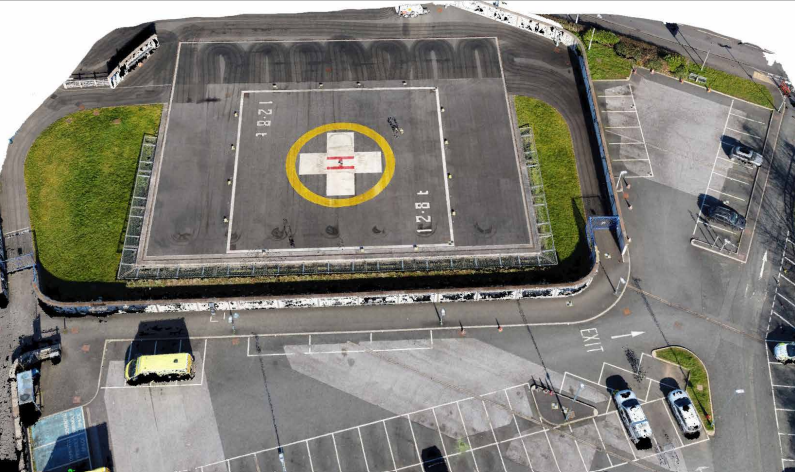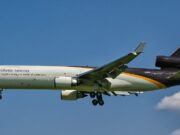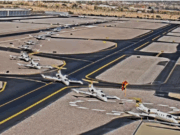
A Sikorsky S-92A was landing at a hospital in Plymouth, England, when downwash generated by the helicopter blew three bystanders to the ground, killing one and leaving another with serious injuries, according to the U.K. Air Accidents Investigation Branch (AAIB).
In its final report on the March 4, 2022, accident at the helicopter landing site (HLS) at Derriford Hospital, the AAIB said that two of the people who were knocked down, including the woman who was killed, were walking on a footpath near the southern edge of the HLS. The third person was in an outdoor parking area. A relative who was walking with the fatally injured woman told investigators of seeing her “lifted off the ground by the downwash before landing on the ground,” the report said. The woman, who appeared unconscious, had suffered a serious head injury.
The relative, who sustained minor injuries, told investigators that although she was aware of signs near the footpath that warned of a “danger of downdraft and flying debris,” she “did not feel they reflected the severity of the danger,” the report said. “Her understanding was that any downdraft might blow someone’s hat off but not physically lift people off their feet.”
The person who was seriously injured said she also was lifted off her feet by the downwash, which dropped her between two cars.
The HLS was constructed in 2015, designed as “a partially raised structure (on a mound)” that could accommodate helicopters weighing up to 12,800 kg (28,219 lb), including the S-92. The HLS structure complied with guidance available at the time, “but that guidance did not adequately address the issue of helicopter downwash,” the report said. “The hazard of helicopter downwash in the car parks adjacent to the HLS was not identified, and the risk of possible injury to uninvolved persons was not properly assessed.”
The report added that the investigation found that hospital representatives were unaware of guidance published after the completion of the HLS.
Investigations of earlier downwash incidents at the HLS, and related complaints, resulted in action to address specific causes, but the investigations never identified a need to manage the downwash hazard in Car Park B, the parking area where one of the three people involved in this accident was injured.
In addition, the investigation of this accident found that the helicopter operator was not aware of the HLS response team’s roles, responsibilities and standard operating procedures and that, although the 5,217-hour copilot believed the hospitals HLS response team staff was only responsible for securing the HLS itself, the 7,239-hour commander believed that the HLS response team staff’s responsibilities extended to the surrounding parking areas. The hospital staff responsible for HLS management focused on mitigating risks within the boundaries of the HLS and not in nearby areas.
In addition, staff members responsible for management of the HLS “had insufficient knowledge about helicopter operations to safely manage the downwash risk around the site,” and their safety management processes “did not result in effective interventions to address the downwash hazard to people immediately outside the HLS,” the report said.
“Safety at hospital HLS throughout the U.K. requires effective information sharing and collaboration between HLS site keepers and helicopter operators,” the report added, but at the time of the accident, there was no convenient mechanism for information sharing between them.”
After the accident, several actions were taken to mitigate the risk, including the hospital HLS site keeper’s orders barring helicopters more than 5,000 kg (11,023 lb) from landing at the site until further notice and closing Car Park B, also until further notice. Pedestrian movements in the parking area and on a nearby roadway also were to be subject to controls during helicopter takeoffs and landings.
In addition, the helicopter operator withdrew approval for its S-92 and Agusta Westland AW 189 helicopters to operate into the HLS until further notice.
Image: AAIB
This article is based on AAIB Aircraft Accident Report AAR 2/2023, “Sikorsky S-92A, G-MCGY; Downwash From Landing Helicopter Resulting in Fatal Injury to Uninvolved Person; Derriford Hospital, Plymouth, Devon, 4 March 2022.” Issued Nov. 2, 2023.


